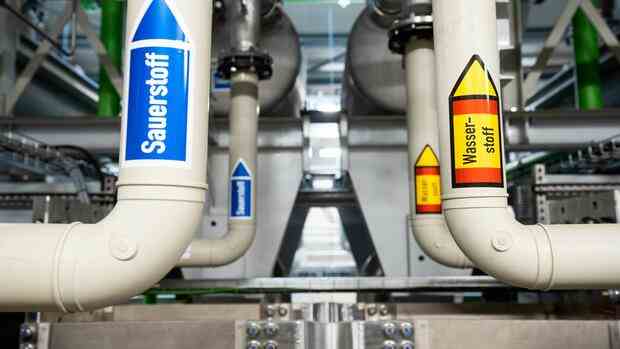Berlin Hydrogen should pave the way to climate neutrality. However, it can also have a strong climate-damaging effect if it escapes uncontrolled. This increases the requirements for the planned construction of a hydrogen infrastructure, because even small leaks can have enormous consequences for the climate.
Stefan Wenzel, Parliamentary State Secretary in the Federal Ministry of Economics, told the Handelsblatt that tightness “plays a central role” in hydrogen applications. He sees a research topic with a view to building a hydrogen infrastructure, “because we will have new technology, many new processes and transport processes worldwide”. It should be “prepared for in the planning,” said Wenzel.
The Federal Institute for Materials Research (BAM) is already working on the topic. The problem of the unintentional release of hydrogen into the atmosphere is known in research, but the goal of ongoing research is “to avoid such releases through technical measures or to reduce them to such a low level that the effects on the climate are negligible “said Kai Holtappels from BAM. This includes research into the materials and materials for pipelines and other hydrogen infrastructure.
Climate neutrality cannot be achieved without hydrogen. Wherever electricity from renewable sources cannot be used directly, climate-neutral hydrogen is the method of choice.
Top jobs of the day
Find the best jobs now and
be notified by email.
This applies, for example, to certain processes in industry, but according to the current state of the art also in shipping, heavy goods and air traffic. The entry into the production of climate-neutral hydrogen and the development of a hydrogen infrastructure are therefore among the central energy and climate policy goals of the traffic light coalition.
Are there any dangers for the climate?
In addition, the conditions are to be created for importing climate-neutral hydrogen from all over the world. At the same time, work is being done at the European level to set up a transnational hydrogen infrastructure.
The centerpiece of this infrastructure is to be a European “hydrogen backbone”, the lines of which, according to the ideas of the companies involved, should already be 27,000 kilometers long by 2030.
But does the hydrogen infrastructure pose a threat to the climate? Scientific studies have recently increased, pointing out the climate-damaging effect of hydrogen if it escapes uncontrolled.
The hydrogen itself has no direct climate-damaging effect. But there are indirect effects: in the atmosphere, it reacts with hydroxide molecules to form water, so there is less hydroxide available for reactions with greenhouse gases. This increases the ozone content in the atmosphere, and methane, which is extremely harmful to the climate, is broken down more slowly.
The result is frightening. “Over a period of 20 years, the indirect climate impact of hydrogen is 33 times higher than the climate impact of carbon dioxide,” says Andrea Lübcke from the German Academy of Science and Engineering (Acatech). Current studies consider even higher values to be possible, but point to large differences depending on the calculation approach.
>> Read here: Seven technologies to solve current problems
This increases the demands on the future hydrogen infrastructure. The operators of the gas networks see themselves prepared for this. They want to make the existing gas lines fit for hydrogen use.
Companies must check for methane leaks
According to the FNB Gas Association, in which the operators of the long-distance gas pipeline networks have joined forces, technical investigations by the industry have shown that existing natural gas pipelines can also be used for the most part to transport hydrogen. “As future transporters of hydrogen, we are aware of the responsibility for the safety of our systems and climate protection,” the association continues.
The indirect climate impact of hydrogen over a period of 20 years is 33 times higher than the climate impact of carbon dioxide. Andrea Lübcke from the German Academy of Science and Engineering (Acatech)
Due to the safety-relevant properties of hydrogen, such as its tendency to self-ignite and the barely visible flames, one will “take the necessary measures to ensure system security and avoid leaks”.
>> Read here: “Use your own potential”: climate protectionists and scientists call for CO2 storage in Germany
Previous studies of converted natural gas plants had shown that plants that did not emit any natural gas did not emit any hydrogen either. “The size of the molecule is irrelevant here. The fundamentally possible diffusion process of hydrogen through welded steel pipes can only be detected under laboratory conditions and with highly sensitive measuring instruments and plays no role in terms of safety or climate impact,” says the FNB Gas. Hydrogen is the smallest element on the periodic table.
The debate about leaks is not new to gas network operators. Only at the end of December last year did the EU member states agree on a regulation to limit methane emissions in the oil and gas industry.
Companies will be required to regularly inspect and repair their plants for methane leaks. Environmental protection organizations had previously built up considerable pressure and warned of the climate risks emanating from uncontrolled methane emissions.
This could develop in a similar way with regard to hydrogen leaks. “The scope of the leakage problem with regard to the hydrogen infrastructure has not yet been properly grasped. When natural gas pipelines are converted to use hydrogen, new problems arise,” said Constantin Zerger from the German Environmental Aid (DUH).
More: Endgame for German industry – three scenarios for the future
